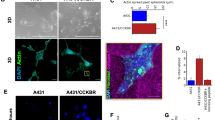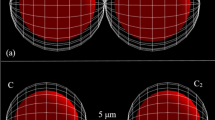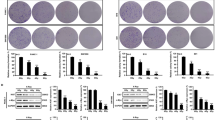Abstract
Bystander responses underlie some of the current efforts to develop gene therapy approaches for cancer treatment. Similarly, they may have a role in strategies to treat tumours with targeted radioisotopes. In this study we show direct evidence for the production of a radiation-induced bystander response in primary human fibroblasts. We utilize a novel approach of using a charged-particle microbeam, which allows individual cells within a population to be selected and targeted with counted charged particles. Individual primary human fibroblasts within a population of 600–800 cells were targeted with between 1 and 15 helium ions (effectively, α-particles). The charged particles were delivered through the centre of the nucleus with an accuracy of ± 2 μm and a detection and counting efficiency of greater than 99%. When scored 3 days later, even though only a single cell had been targeted, typically an additional 80–100 damaged cells were observed in the surviving population of about 5000 cells. The yield of damaged cells was independent of the number of charged particles delivered to the targeted cell. Similar results of a 2–3-fold increase in the background level of damage present in the population were observed whether 1 or 4 cells were targeted within the dish. Also, when 200 cells within one quadrant of the dish were exposed to radiation, there was a 2–3-fold increase in the damage level in an unexposed quadrant of the dish. This effect was independent of the presence of serum in the culture medium and was only observed when a cell was targeted, but not when only the medium was exposed, confirming that a cell-mediated response is involved. © 2001 Cancer Research Campaign
Similar content being viewed by others
Article PDF
Change history
16 November 2011
This paper was modified 12 months after initial publication to switch to Creative Commons licence terms, as noted at publication
References
Abend M, Kehe K, Riedel M and Van Beuningen D (2000) Correlation of micronucleus and apoptosis assays with reproductive cell death can be improved by considering other modes of death. Int J Radiat Biol 76: 249–259
Azzam EI, de Toledo SM, Gooding T and Little JB (1998) Intercellular communication is involved in the bystander regulation of gene expression in human cells exposed to very low fluences of alpha particles. Radiat Res 150: 497–504
Belyakov OV, Prise KM, Mothersill C, Folkard M and Michael BD (2000) Studies of bystander effects in primary urothelial cells using a charged-particle microbeam. Radiat Res 153: 235
Bishayee A, Rao DV and Howell RW (1999) Evidence for pronounced bystander effects caused by nonuniform distributions of radioactivity using a novel three-dimensional tissue culture model. Radiat Res 152: 88–97
Boyd M, Cunningham SH, Brown MM, Mairs RJ and Wheldon TE (1999) Noradrenaline transporter gene for radiation kill by 131I meta-iodobenzylguanidine. Gene Ther 6: 1147–1152
Deshpande A, Goodwin EH, Bailey SM, Marrone BL and Lehnert BE (1996) Alpha-particle-induced sister chromatid exchange in normal human lung fibroblasts: Evidence for an extranuclear target. Radiat Res 145: 260–267
Emerit I (1994) Reactive oxygen species, chromosome mutation, and cancer: possible role of clastogenic factors in carcinogenesis. Free Rad Biol Med 16: 99–109
Folkard M, Vojnovic B, Hollis KJ, Bowey AG, Watts SJ, Schettino G, Prise KM and Michael BD (1997a) A charged particle microbeam: II A single-particle micro-collimation and detection system. Int J Radiat Biol 72: 387–395
Folkard M, Vojnovic B, Prise KM, Bowey AG, Locke RJ, Schettino G and Michael BD (1997b) A charged-particle microbeam. I. Development of an experimental system for targeting cells individually with counted particles. Int J Radiat Biol 72: 375–385
ICRP: Human respiratory tract model for radiological protection A report of a Task Group of the International Commission on Radiological Protection, (1994). Ann ICRP 24: 1–482
Iyer R and Lehnert BE (2000) Factors underlying the cell growth-related bystander responses to alpha particles. Cancer Res 60: 1290–1298
Khan MA, Hill RP and Van Dyk J (1998) Partial volume rat lung irradiation: an evaluation of early DNA damage. Int J Radiat Oncol Biol Phys 40: 467–476
Kerr JF, Wyllie AH and Currie AR (1972) Apoptosis: a basic biological phenomenon with wide-ranging implications in tissue kinetics. Br J Cancer 26: 239–257
Lehnert BE and Goodwin EH (1997) Extracellular factor(s) following exposure to α-particles can cause sister chromatid exchanges in normal human cells. Cancer Res 57: 2164–2171
Little JB (2000) Radiation carcinogenesis. Carcinogenesis 21: 397–404
Lorimore SA, Kadhim MA, Pocock DA, Papworth D, Stevens DL, Goodhead DT and Wright EG (1998) Chromosomal instability in the descendants of unirradiated surviving cells after alpha-particle irradiation. Proc Natl Acad Sci USA 95: 5730–5733
Mesnil M, Piccoli C, Tiraby G, Willecke K and Yamasaki H (1996) Bystander killing of cancer cells by herpes simplex virus thymidine kinase gene is mediated by connexins. Proc Natl Acad Sci USA 93: 1831–1835
Michael BD, Belyakov OV, Folkard M, Malcolmson AM, Ozols A and Prise KM (2000) Implications of bystander effects for radiobiology. In: M Moriarty, C Mothersill, C Seymour, M Edington, JF Ward, R JM Fry (Eds) Radiation Research Vol. 2, Allen Press: Lawrence, KS. pp. 397–402
Mothersill C and Seymour CB (1998) Cell–cell contact during gamma irradiation is not required to induce a bystander effect in normal human keratinocytes: evidence for release during irradiation of a signal controlling survival into the medium. Radiat Res 149: 256–262
Mothersill C, Stamato TD, Perez ML, Cummins R, Mooney R and Seymour CB (2000) Involvement of energy metabolism in the production of ‘bystander effects’ by radiation. Br J Cancer 82: 1740–1746
Nagasawa H and Little JB (1992) Induction of sister chromatid exchanges by extremely low doses of α-particles. Cancer Res 52: 6394–6396
Nagasawa H and Little JB (1999) Unexpected sensitivity to the induction of mutations by very low doses of alpha-particle radiation: evidence for a bystander effect. Radiat Res 152: 552–557
Narayanan PK, Goodwin EH and Lehnert BE (1997) α-particles initiate biological production of superoxide anions and hydrogen peroxide in human cells. Cancer Res 57: 3963–3971
Narayanan PK, LaRue KE, Goodwin EH and Lehnert BE (1999) Alpha particles induce the production of interleukin-8 by human cells. Radiat Res 152: 57–63
Ozols A, Prise KM, Trott K-R, Folkard M and Michael BD (2000) The role of oxidative stress and DNA damage in genomic instability: targeted microbeam studies in primary human fibroblasts. Radiat Res 153: 229–230
Prise KM, Belyakov OV, Folkard M and Michael BD (1998) Studies of bystander effects in human fibroblasts using a charged particle microbeam. Int J Radiat Biol 74: 793–798
Seymour CB and Mothersill C (1997) Delayed expression of lethal mutations and genomic instability in the progeny of human epithelial cells that survived in a bystander-killing environment. Radiat Oncol Invest 5: 106–110
Seymour C and Mothersill C (1999) Cell communication and the “bystander effect”. Radiat Res 151: 505–506
Ward JF (2000) Non-DNA targeted effects and DNA models. In: M Moriarty, C Mothersill, C Seymour, M Edington, JF Ward, R JM Fry (Eds) Radiation Research, Allen Press: Lawrence, KS. pp. 336–341
Zhou H, Randers-Pehrson G, Waldren CA, Vannais D, Hall EJ and Hei TK (2000) Induction of a bystander mutagenic effect of alpha particles in mammalian cells. Proc Natl Acad Sci USA 97: 2099–2104
Author information
Authors and Affiliations
Rights and permissions
From twelve months after its original publication, this work is licensed under the Creative Commons Attribution-NonCommercial-Share Alike 3.0 Unported License. To view a copy of this license, visit http://creativecommons.org/licenses/by-nc-sa/3.0/
About this article
Cite this article
Belyakov, O., Malcolmson, A., Folkard, M. et al. Direct evidence for a bystander effect of ionizing radiation in primary human fibroblasts. Br J Cancer 84, 674–679 (2001). https://doi.org/10.1054/bjoc.2000.1665
Received:
Revised:
Accepted:
Published:
Issue date:
DOI: https://doi.org/10.1054/bjoc.2000.1665
Keywords
This article is cited by
-
The role of connexin proteins and their channels in radiation-induced atherosclerosis
Cellular and Molecular Life Sciences (2021)
-
An Integrated Preprocessing Approach for Exploring Single-Cell Gene Expression in Rare Cells
Scientific Reports (2019)
-
Voxel model of individual cells and its implementation in microdosimetric calculations using GEANT4
Radiation and Environmental Biophysics (2014)
-
Double-strand breaks and the concept of short- and long-term epigenetic memory
Chromosoma (2011)
-
Processing of abasic DNA clusters in hApeI-silenced primary fibroblasts exposed to low doses of X-irradiation
Journal of Biosciences (2011)



